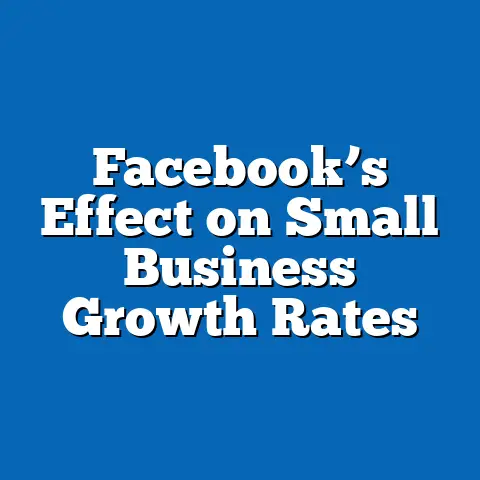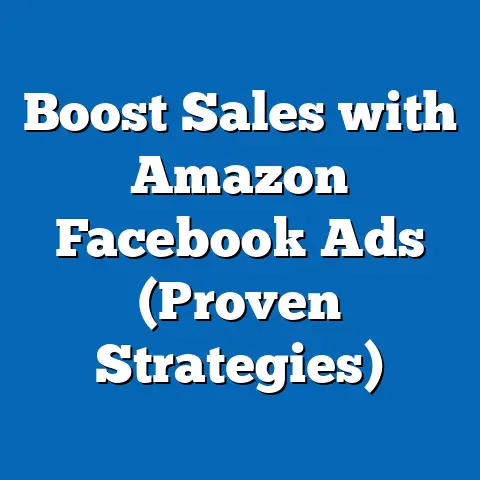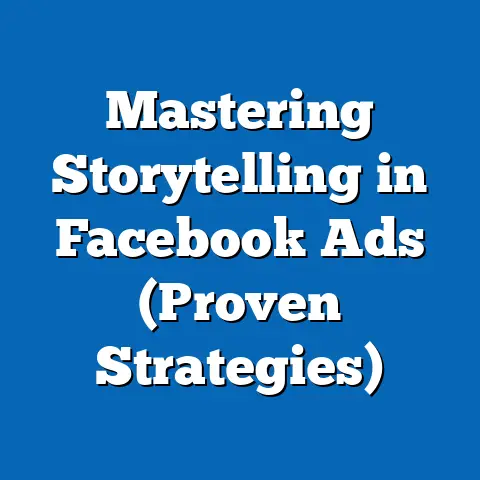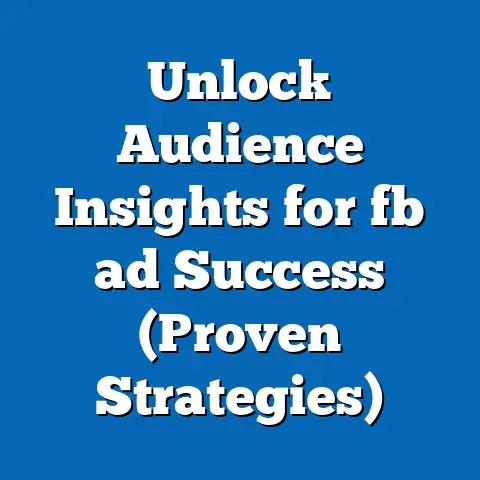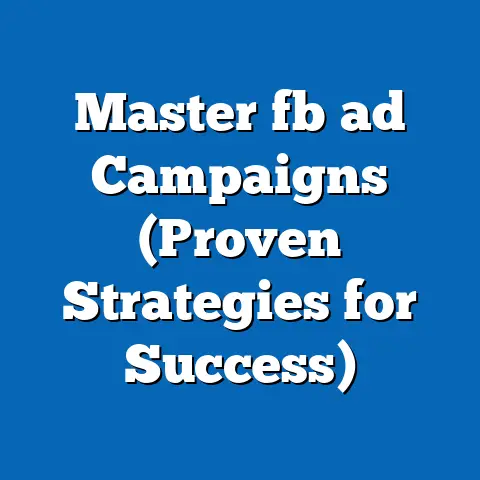Canceling Facebook Ad: Essential Strategies (Expert Tips)
Digital advertising has become an integral part of any modern business strategy. Platforms like Facebook offer unparalleled reach and targeting capabilities. However, not every campaign is a success. Knowing when and how to safely cancel Facebook ads is crucial for protecting your brand’s finances and reputation. I’ve seen firsthand how a poorly managed campaign can quickly drain a budget and damage brand perception. That’s why this guide is designed to provide you with the knowledge and strategies you need to navigate the process of canceling ads effectively and safely.
Understanding the Facebook Ads Ecosystem
Before diving into the specifics of canceling ads, it’s essential to understand the broader context of the Facebook Ads ecosystem.
Overview of Facebook Ads
Facebook Ads are paid messages that businesses use to reach a specific audience on Facebook and its affiliated platforms, like Instagram. These ads can take many forms, including images, videos, carousels, and collections. Each format serves a different purpose, from driving website traffic to generating leads or increasing brand awareness.
- Image Ads: Simple yet effective, ideal for showcasing products or services.
- Video Ads: Engaging and dynamic, perfect for storytelling and capturing attention.
- Carousel Ads: Allow users to scroll through multiple images or videos, ideal for showcasing a range of products or features.
- Collection Ads: Combine images and videos to create an immersive shopping experience.
I remember working with a client who was launching a new line of eco-friendly clothing. We used carousel ads to showcase each item in the collection, highlighting the sustainable materials and ethical production processes. This approach not only increased website traffic but also resonated with their target audience, leading to a significant boost in sales.
Reasons for Cancelling Facebook Ads
There are numerous reasons why you might need to cancel a Facebook ad campaign. These can range from poor performance and budget constraints to strategic pivots and changes in business goals.
- Poor Performance: Ads that fail to generate the desired results (low CTR, high cost per acquisition) need to be re-evaluated.
- Budget Constraints: Limited resources may necessitate canceling campaigns to prioritize more effective strategies.
- Strategic Pivots: Changes in business objectives or target audience may require a shift in advertising focus.
- Creative Fatigue: Over time, ads can lose their effectiveness as users become desensitized to the messaging.
- External Factors: Market changes, seasonal trends, or unforeseen events can impact ad performance.
According to a recent study by HubSpot, nearly 60% of marketers adjust their advertising strategies mid-campaign due to performance issues. This underscores the importance of being proactive and ready to make changes when necessary.
Assessing the Need to Cancel
Before pulling the plug on a campaign, it’s crucial to thoroughly assess its performance and understand the underlying reasons for any issues.
Analyzing Ad Performance Metrics
Key Performance Indicators (KPIs) are the metrics that indicate how well your ads are performing. Monitoring these KPIs is essential for determining whether to continue, pause, or cancel an ad campaign.
- Click-Through Rate (CTR): Measures the percentage of users who click on your ad after seeing it. A low CTR may indicate poor ad relevance or targeting issues.
- Conversion Rate: Tracks the percentage of users who complete a desired action (e.g., purchase, sign-up) after clicking on your ad. A low conversion rate may suggest issues with your landing page or offer.
- Return on Ad Spend (ROAS): Calculates the revenue generated for every dollar spent on advertising. A low ROAS indicates that your ads are not generating enough profit to justify the investment.
- Cost Per Acquisition (CPA): Measures the cost of acquiring a new customer through your ad campaign. A high CPA may indicate inefficiencies in your targeting or ad creative.
- Cost Per Click (CPC): Indicates the amount you pay each time someone clicks on your ad. Monitoring CPC can help you identify trends and optimize your bidding strategy.
I once worked on a campaign where the CTR was consistently low, but the conversion rate was high. After analyzing the data, we realized that the ad copy was not effectively communicating the value proposition, but those who did click were highly interested in the product. By refining the ad copy to better align with the target audience’s needs, we were able to significantly improve the CTR and overall campaign performance.
Understanding Audience Feedback
Audience engagement and feedback are invaluable sources of information about how your ads are being received. Monitoring comments, shares, and reactions can provide insights into public sentiment and help you identify potential issues.
- Comments: Analyze comments to understand what users are saying about your ads. Look for patterns and common themes.
- Shares: Track how many users are sharing your ads. A high share rate indicates that your content is resonating with the audience.
- Reactions: Monitor the types of reactions (e.g., Like, Love, Haha) to gauge emotional responses to your ads.
- Negative Feedback: Pay attention to negative feedback, such as users hiding ads or reporting them. This can indicate serious issues with your targeting or creative.
I recall a campaign where we received a lot of negative comments about the ad’s tone. Users felt it was insensitive and out of touch with current events. We immediately paused the campaign and revised the ad copy to be more empathetic and relevant. This not only improved audience sentiment but also boosted overall ad performance.
Strategies for Safely Canceling Ads
Canceling a Facebook ad is a straightforward process, but it’s essential to follow the correct steps to ensure that your account remains in good standing and that you have a clear record of your campaign performance.
Step-by-Step Guide to Cancelling Ads
Here’s a detailed, step-by-step process for canceling ads through the Facebook Ads Manager:
-
Log in to Facebook Ads Manager: Go to facebook.com/adsmanager and log in to your account.
-
Navigate to Campaigns, Ad Sets, or Ads: Depending on the level at which you want to cancel, select the appropriate tab.
-
Select the Campaign, Ad Set, or Ad: Find the specific item you want to cancel.
-
Toggle the Status Switch: Click the toggle switch next to the campaign, ad set, or ad to turn it off. The status will change from “Active” to “Inactive.”
-
Confirm the Cancellation: A confirmation message will appear to verify that the item has been canceled.
-
Optional: Delete the Campaign, Ad Set, or Ad: If you no longer need the item, you can delete it. Be cautious, as this action is irreversible.
Log in to Facebook Ads Manager: Go to facebook.com/adsmanager and log in to your account.
Navigate to Campaigns, Ad Sets, or Ads: Depending on the level at which you want to cancel, select the appropriate tab.
Select the Campaign, Ad Set, or Ad: Find the specific item you want to cancel.
Toggle the Status Switch: Click the toggle switch next to the campaign, ad set, or ad to turn it off. The status will change from “Active” to “Inactive.”
Confirm the Cancellation: A confirmation message will appear to verify that the item has been canceled.
Optional: Delete the Campaign, Ad Set, or Ad: If you no longer need the item, you can delete it. Be cautious, as this action is irreversible.
Visual Aid:
- Screenshot 1: Facebook Ads Manager interface, highlighting the Campaigns tab.
- Screenshot 2: The toggle switch to turn off a campaign.
- Screenshot 3: Confirmation message after canceling a campaign.
I always recommend taking screenshots of the Ads Manager interface before and after canceling a campaign. This provides a visual record of the changes and can be helpful for troubleshooting any issues that may arise.
Documenting Campaign Performance
Before canceling an ad, it’s crucial to document its performance. This data can provide valuable insights into what worked and what didn’t, informing future campaigns.
- Record Key Metrics: Capture data on CTR, conversion rates, ROAS, CPA, CPC, and any other relevant KPIs.
- Analyze Audience Demographics: Note the demographics of users who engaged with your ad (age, gender, location, interests).
- Review Ad Creative: Save copies of your ad creative (images, videos, ad copy) for future reference.
- Document Targeting Settings: Record the targeting parameters you used (interests, behaviors, custom audiences).
Tools and Methods for Tracking Performance Data:
- Facebook Ads Manager Reports: Use the built-in reporting tools in Facebook Ads Manager to generate detailed performance reports.
- Google Analytics: Integrate Google Analytics with your Facebook Ads account to track website traffic and conversions.
- Spreadsheets: Use spreadsheets (e.g., Excel, Google Sheets) to organize and analyze your performance data.
- Data Visualization Tools: Consider using data visualization tools (e.g., Tableau, Power BI) to create interactive dashboards and reports.
I’ve found that creating a simple spreadsheet with key metrics and audience demographics is an effective way to track campaign performance over time. This allows you to quickly identify trends and patterns, making it easier to optimize your strategies.
Communicating with Stakeholders
Canceling an ad campaign can have implications for various stakeholders, including team members, clients, and customers. Effective communication is essential for managing expectations and maintaining trust.
Notifying Team Members
When canceling an ad campaign, it’s important to inform your team members promptly and transparently.
- Schedule a Meeting: Arrange a meeting to discuss the reasons for the cancellation and the insights gained from the process.
- Share Performance Data: Present the performance data and analysis that led to the decision to cancel.
- Solicit Feedback: Encourage team members to share their thoughts and suggestions.
- Document the Discussion: Keep a record of the meeting, including key decisions and action items.
I once worked on a project where the team was initially resistant to canceling a poorly performing campaign. However, after presenting the data and explaining the potential financial losses, they understood the need for change. By involving them in the decision-making process, we were able to gain their buy-in and move forward with a new strategy.
Handling Customer Expectations
If your ad cancellation affects customers (e.g., a promotion is no longer available), it’s crucial to address their concerns proactively.
- Be Transparent: Explain the reasons for the cancellation in a clear and honest manner.
- Offer Alternatives: Provide alternative promotions or offers to compensate for the cancellation.
- Apologize for Any Inconvenience: Express sincere apologies for any disappointment or frustration caused by the cancellation.
- Monitor Social Media: Keep an eye on social media channels for customer feedback and respond promptly to any inquiries.
I’ve learned that transparency and empathy are key to maintaining customer trust during ad cancellations. By acknowledging their concerns and offering viable alternatives, you can turn a potentially negative situation into an opportunity to strengthen your relationship with your audience.
Learning from Cancellation
Canceling a Facebook ad is not a failure; it’s an opportunity to learn and improve your future strategies.
Analyzing What Went Wrong
Conduct a thorough analysis of the canceled campaign to identify the root causes of its underperformance.
- Review Targeting Settings: Evaluate whether your targeting parameters were appropriate for your target audience.
- Assess Ad Creative: Determine whether your ad creative was engaging and relevant to your audience.
- Analyze Landing Page Performance: Evaluate whether your landing page was optimized for conversions.
- Identify Technical Issues: Check for any technical issues that may have affected ad performance (e.g., broken links, slow loading times).
Common Pitfalls to Avoid:
- Poor Targeting: Targeting the wrong audience can lead to low engagement and high costs.
- Irrelevant Ad Creative: Ads that don’t resonate with the target audience will fail to generate results.
- Slow Landing Pages: Slow loading times can frustrate users and lead to high bounce rates.
- Lack of Mobile Optimization: Ads that aren’t optimized for mobile devices will perform poorly on mobile platforms.
I once worked on a campaign where the landing page was not optimized for mobile devices. As a result, the conversion rate was significantly lower on mobile than on desktop. By optimizing the landing page for mobile, we were able to dramatically improve the overall campaign performance.
Adjusting Future Strategies
Apply the insights gained from the canceled ad to refine your future advertising strategies.
- Refine Targeting Parameters: Use the data to identify more effective targeting parameters.
- Improve Ad Creative: Revise your ad creative to be more engaging and relevant to your audience.
- Optimize Landing Pages: Ensure that your landing pages are optimized for conversions and mobile devices.
- Conduct A/B Testing: Test different ad variations to identify the most effective strategies.
Expert Tips for Ongoing Testing and Optimization:
- Continuously Monitor Performance: Regularly track your KPIs and make adjustments as needed.
- Experiment with New Ad Formats: Explore different ad formats to see which ones perform best for your target audience.
- Stay Up-to-Date with Platform Changes: Keep abreast of the latest features and updates on the Facebook Ads platform.
- Seek Expert Advice: Consult with digital marketing professionals to get expert guidance and insights.
I’ve found that ongoing testing and optimization are essential for long-term success in Facebook advertising. By continuously experimenting with new strategies and refining your approach based on data, you can maximize your ROI and achieve your business goals.
Conclusion
Safely canceling Facebook ads is a critical skill for any digital marketer. It’s not just about stopping a campaign; it’s about protecting your brand’s reputation, finances, and data security. By understanding the Facebook Ads ecosystem, assessing the need to cancel, following a step-by-step guide, communicating with stakeholders, and learning from cancellation, you can navigate the process effectively and safely.
Remember, canceling an ad is not a failure but an opportunity for growth and improvement. Embrace it as a chance to refine your strategies, optimize your campaigns, and achieve greater success in the dynamic world of digital advertising.

